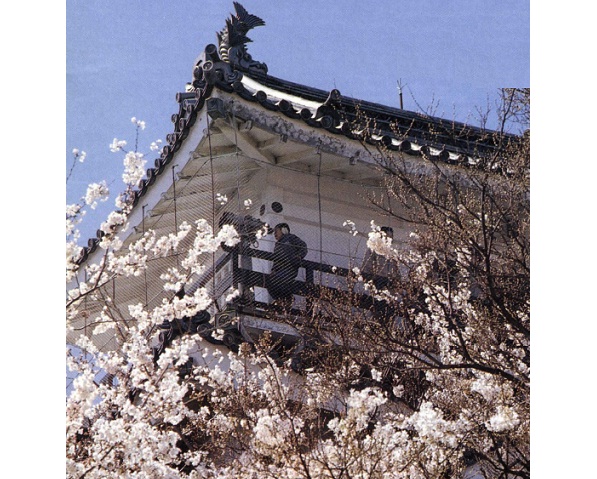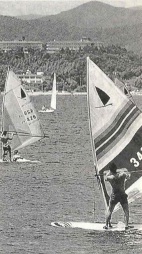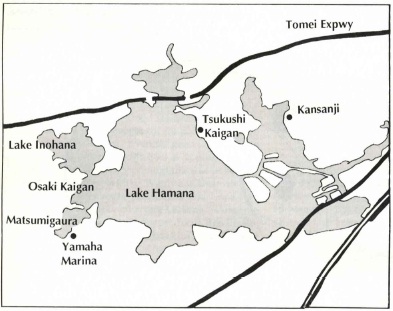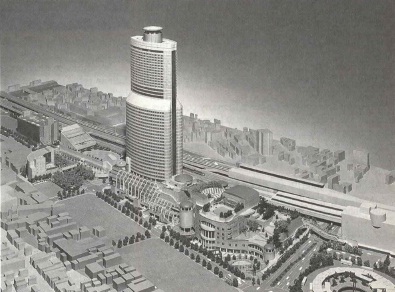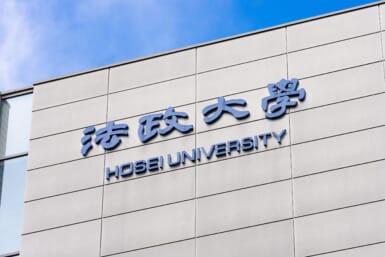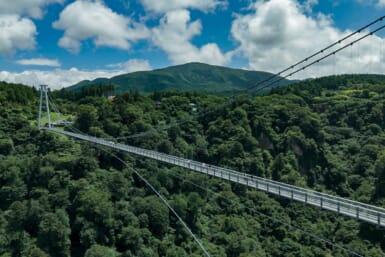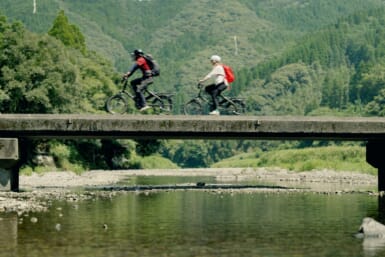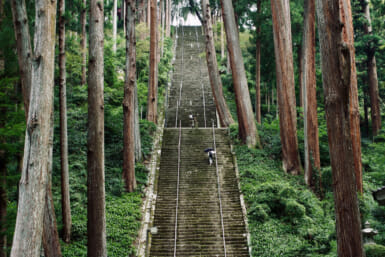Hamamatsu—almost precisely half way between Tokyo and Osaka in Shizuoka-ken—is a community in transition. Always blessed with scenic beauty and a mild, near-tropical climate, the city of 500,000-plus is cradled between a gloriously verdant mountain range on one side and the Pacific Ocean on the other. Lake Hamana is a surefire tourist draw with water-sports enthusiasts coming from all over Japan to frolic on and in the cyrstal-clear waters. Now the city fathers have embarked on a bold new expansion plan which will place Hamamatsu even more indelibly on the list of “must see” spots in Japan.
Ambiance of small town intimacy & friendships; convenience & efficiency of big-city living
If you were a darts player and hit the bullseye, supposing a map of Japan was your target, you’d land right on the Shizuoka-ken city of Hamamatsu. Centrally ‘located between the nations’ two major cities, Tokyo and Osaka, this burgeoning mini-metropolis has something most of us desire in a place to live or work: the friendly ambience of a small town combined with the convenience of big-city amenities. Among the 570,000-odd inhabitants are several thousand foreigners, 11,000 of whom are Brazilian nisei. Thus, about 2 percent of the population is gaijin.
The area has always been blessed by abundant natural beauty with the verdant Akashi mountain range to the north and the waters of the Pacific to the south; east of Hamamatsu is the surging Tenryu River, westward is the glorious Lake Hamana. The vagaries of geography have worked to give the area a semi-tropical climate year-round, normally sunny and warm despite what the weatherman deems seasonal for other sections of the land. The average winter temperature is 8.3C (46F) and 24C (75F) in summer. Because of this moderate climate, Hamamatsu has always enjoyed an abundance of plant life and wild-animal population in the neighboring forests and mountains.
In short, Hamamatsu is a rich city—in natural wealth, as well as unlimited materialistic possibilities. Now, in addition to all the other pluses, the city fathers, in cooperation with the Daiichi Mutual Life Insurance Company Group, have a dramatic addition to their growing skyline: ACT City, a dynamic, structurally stunning business complex with a high-rise edifice at the center.
Perhaps because of its central location and the moderate climate, this area of Japan was the domain of ancient rulers of the country, even before the Tokugawa Period. Such legendary samurai leaders as Oda Nobunaga, his successor Toyotomi Hideyoshi and Tokugawa Ieyasu, operated out of what became Hamamatsu. The name “Hamamatsu” was given the town by Tokugawa Ieyasu who built his castle, Shusse-jo —”the castle of success”—on the site, so named because each of the lords who reigned from the castle attained ever-growing status in the Empire. Tokugawa became a shogun from this location and launched the Tokugawa Period which lasted 300 years, just preceding the Meiji Period. Hamamatsu was one of the famed 53 Edo Era stations along the Tokaido.
The renown of the Hamamatsu area is probably more far-flung than even the city fathers suspect. Even though many people over the world never heard of the name of the city, they surely know the names of famed Japanese products produced and manufactured there: Honda, Yamaha, Suzuki, both motorcycles and automobiles; musical instruments and textiles. Hamamatsu is famed with musicians over the globe for the superb quality of the musical instruments made there; in fact, virtually all the pianos made in Japan come from this area. Both Yamaha and Kawai instrument manufacturing companies originated here. Perhaps, then, it is fitting that Hamamatsu in recent years has become a center for international musical exchange programs, festivals, the promotion of an up-and-coming local orchestra and home-town bands. Many musicians have elected to move to the area for the particular ambiance to enhance their creativity.
In addition to the musical world, businessmen have begun to show preference for Hamamatsu as a location for offices, conventions and leisure facilities. One of the primary reasons for this influx of industrial and commercial firms is the proximity to the leisure spots surrounding Lake Hamana with its multiple water-sports facilities. The advent of ACT City is only one among several lures for expanding business ventures. In addition to the transportation industry— motorcycles and automobiles— the area is home to the production of machinery plants, pharmaceuticals, electrical goods and a bustling food industry.
Although Lake Hamana is probably best known for being an aquatic playground for sports enthusiasts, it is also renown among gourmets of Japan as the spawning grounds of the most delectable eels and fresh-water oysters in the country. True, the enormous Hamana-ko (68.9 square kilometers) is, indeed a fresh-water lake; it empties into the Pacific Ocean, thereby making at least a portion of it a salt-water body of water, creating an interesting phenomenon perfect for the breeding of unagi (eels).
The breeding of eels in this area began in the Meiji Era in Tokyo’s deep rivers; in the latter part of the Meiji Era, eel breeding was inaugurated in Lake Hamana, a process that evolved into the raising of baby eels (shirasu unagi), a special agricultural-industrial boon to the area. Of the total Japan-wide annual consumption of eels, placed at around 20,000 tons, more than 30 percent come from Lake Hamana.
More and more commercial planners, movers and shakers are becoming to prefer Hamamatsu as a location for business offices, convention sites and leisure activities because of the proximity to both Osaka and Tokyo and the aforementioned mild climate. Plans for the future include projects ranging from development of a research resort on the banks of Lake Hamana to the ACT City project, the completion of which will dramatically increase the number of facilities available for seminars, conventions, business meetings and leisure activities.
Says Hamamatsu Mayor Masaru Kurihara: “Our city has been improved by the prosperous vitality of local industries such as the recently developed optical and electronic industries, in addition to musical instruments, transportation machines and textiles. Aiming for ‘an affluent people-oriented city in harmony with industry and culture,’ Hamamatsu City is taking bigger steps toward the 21st century with new-city projects, such as the Hamamatsu Technopolis plan, the International Convention City concept and plans for a music and culture city, among others.”
Fantastic leisure activities, water sports
Spring in Hamamatsu is an exciting time of growth, beauty and spiritual renovation. The colorful elegance of the season is found throughout the city, especially in the panoramic splendor of Flower Park, alongside the very popular Hamamatsu Zoo. Bicycle rides are also popular along the breathtakingly beautiful Coastal Pacific Cycling Route; another excursion popular among the local citizens explores the clam-picking grounds near the lake. In the coming weeks following publication of this Weekender article, the cherry blossoms will burst forth on the boughs of the abundant sakura trees.
Summertime is when Lake Hamana comes into its own. Swimming, wind surfing, water skiing and sailing are just a few of the fun-filled activities which monopolize the lake area during o-natsu. One of the primary reasons for the astonishing popularity of Lake Hamana is the crystal-clear waters; one can literally see for tens of meters below the surface in the clear, clean waters of the lake. Fishermen inevitably find their way to these sparkling waters, for there are more than 300 varieties of fish under the surface. Beautiful, sun-soaked beaches line the lakefront, allowing sun-worshippers to work on their tan, interspersed with frequent dashing forays into the pure waters of the lake. Enlivening the summer evenings for leisure lovers are fireworks displays each weekend.
Encircling the lake are a number of hot springs, the most famous of such is Kanzanji Hot Springs with a scenic setting and breathtaking lookout. One can reach this lovely location by a spectacular cable car ride from which, on a clear day, Mount Fuji can been seen on one side, the Pacific on the other. An exciting place during the day for a variety of marine sports on the lake; a quiet and relaxing place at night. The many hot springs in the area provide tranquility for the mind and refreshing comfort and renewal for the body. Many fine restaurants abound in the immediate area.
For golf enthusiasts, the Hamamatsu area will prove to be a godsend. With the aforementioned beauty of the surroundings and the semi-tropical climate, golf in Shizuoka is most pleasant, indeed. In the immediate area of Hamamatsu there are 11 first-rate golf courses with access available for the visitor. Six are 18-hole layouts, three 27 holes and two with 36.
Many other diversions are unique to the Hamamatsu area, one of which will dominate the area early next month. The Hamamatsu Kite Festival is world famous and considered one of the most exhilarating festivals in Japan. Held each May 3-5, the event will see more than 1,000 giant, colorful kites flown by teams from all over the city and surrounding areas.
Visitors from all over the world congregate at Hamamatsu to watch as more than 130 teams from each township fly their own enormous kites painted with astonishing designs and colors for the first-born sons of their districts. Skill and experience are required for the teams of 50 to 70 members to fly these kites high in the sky where they do battle by attempting to cut down rival kites.
At night, sensational parades of beautiful carved festival floats, their entourages and wild dancing— neri—can be seen throughout the city. This festival is a “must” for visitors to Japan. However, if you are unable to visit Hamamatsu during this time, you can still experience the excitement at the Hamamatsu Festival Pavilion in Nakatajima.
If the water beckons you more than the air, take note: Two windsurfing tournaments are close on the calendar—the Omaezaki All Japan Fun Board Championships and the Sometime World Cup ’93. These tournaments take advantage of Omaezaki’s near perfect windsurfing conditions—strong winds blow more than 140 days of the year over Hamanako’s smooth surface. The top professional windsurfers call it the best windsurfing on earth.
The Omaezaki All Japan Fun Board Championships will be held April 9-11 on the Omaezaki Shiroiwa Seaside. Contact Omaezaki Machi Tourist Association at 0548-63-2001 for details.
The Sometime World Cup ’93, one of Japan’s most important windsurfing competitions, celebrates its 10th anniversary this year. Don’t miss this opportunity to see the world’s greatest surfboarders in action at Omaezaki’s Long Beach. Contact Nihon Fun Board Renpo Jimu Kyoku for details. (See box for other windsurfing spots near Hamamatsu.)
Information on these—and many other—activities can be obtained from HICE, the Hamamatsu Association for International Communications and Exchanges (Tel: 053-458-2170), established to promote greater understanding among Hamamatsu residents of other countries and other ways of life. The aim of the organization is to contribute to greater international understanding that will eventually lead to world peace.
Act City: Impressive 212.7-meter, 45-story tower to be key symbol as Hamamatsu’s ‘Gateway to the Future’
The civic profile of Hamamatsu will take on a new, dramatic change next year when the stunning ACT City rises and spreads over several blocks, to be located immediately outside the railway station exit. Centerpiece of the modern complex will be the ACT Tower rising an mpressive 45 floors into the Shizuoka firmament, for-“‘ever glamorizing and altering the Hamamatsu skyline. Promoted by city fathers as “ACT City: A Gateway to the Future,” the complex will consist of main and medium-sized halls, an International Congress Center, the ACT Tower, exhibition and event hall, a research and seminar center. The top floors of the tower will comprise the Okura ACT City Hotel.
Says Hamamatsu Mayor Masaru Kurihara: “As an urban promotion base for our concept of Hamamatsu expansion, the ACT City plan is a development project operated by the joint public/private efforts of the Hamamatsu Municipal Government in partnership with the Daiichi Mutual Life Insurance Company Group. By providing city space combining high-level urban functions such as music, culture, industrial technology and information-communication, we are constructing ACT City with the aim of becoming an elegant urban center easily accessible to its citizens and rich in culture.”
One of the primary thrusts of this new urban complex will be to foment musical-cultural exchange with this central-Japan city and the rest of the world. Hamamatsu City is working to transform itself into a “City of Music.” ACT City will serve as its focal point, with such facilities as a hall able to accommodate a full-scale opera, a music-oriented hall, a musical conservatory and musical plaza. Diverse musical events—such as the San Remo Festival, the Chopin Festival, the Hamamatsu International Piano Competition and the international congress of the World Association for Symphonic Bands and Ensembles—will be sponsored next year, with ACT City as center stage.
A Hamamatsu spokesman continued: “With the integration of ACT City into the life of our citizens, great numbers of people will surely visit our city from all over the nation—and the world. Musical-cultural exchanges will spread nationally and world-wide.”
ACT City is to become a symbolic gateway for Hamamatsu’s entrance into the 21st century. The design concept has taken the people and environment into consideration, and is carefully planned in harmony with its surroundings. In order to create city space suitable for the city’s population, ACT City will include:
• a transportation plan taking into careful account the flow of people and vehicles;
• measures to counter wind damage and electronic interference;
• a multi-level park with rich greenery centering on ACT Tower as its symbol;
• a moving footway from the station, a sunken plaza and galleria mall which will encourage the circulation of visitors to all parts of ACT City.
Regarding the elegant tower: the first eight floors will house shops, boutiques, cocktail lounges, banquet halls, banking facilities, parking areas and the Okura ACT City Hotel lobby. Offices will occupy floors 10-27. An information communications center will be located on the 27th floor; fitness studio, swimming pool and gymnasium on the 29th; lounges, bars and a medium-sized banquet hall of the 30th, a luxurious restaurant on the 31st. Okura guest rooms will be found on the 32nd through 44th floors, built around an elegant atrium. The observation gallery will be on top of the tower, the 45th floor. A heliport tops the entire affair, all 212.7 meters of it.
This will make the ACT Tower the tallest structure in Japan, excepting the two metropolitan areas of Osaka and Tokyo.
The city spokesman continued: “We envision ACT City to be filled with music from around the world. Hamamatsu has been known for a long time as the center for the manufacture of musical instruments; now we will become famed as a ‘city of music’ Ours is a community in which nearly everyone simply loves music; thus, it’s a place where music can be enjoyed almost any time, throughout the year. We anticipate that our town will soon be known far and wide as ‘Music City Hamamatsu.’ Furthermore, on the shore of Lake Hamana, the development of the Shizuoka Prefectural Music Park is underway. When completed, we are confident it will become the pride of Japan, renowned the world over.”
And ACT City will be filled with music from all over the globe. After negotiating the underpass, visitors will enter the Sunken Plaza, the open lobby, main and medium-sized halls and the International Congress Center. The medium-sized hall is a music-oriented space with excellent acoustic qualities, equipped with a pipe organ; it seats 1,064.
The Main Hall can seat 2,475 music patrons; not only can it be used for international conventions, but also, it provides a quadruple stage (the first in Japan) and the latest equipment, enabling it to cater to any facet of stage art, including full-scale opera, ballet or even Kabuki productions.
So, it’s obvious that the completion of the dynamic ACT City in downtown Hamamatsu will surely mark one of the most important and ambitious civic advancements in Japan in many years. For further information on ACT City, including leaseing available spaces, please call The Daiichi Mutual Life Insurance Company, Property Lease Contract Division, Mr. Sakurada, tel: (03) 5561-5304.

